HISTORY OF PASCO COUNTYFire Departments in Pasco CountyThis page was last revised on Feb. 12, 2022. Corrections and additions are welcome via email to Archivist, West Pasco Historical Society. ANCLOTE RIVER-ELFERS VOLUNTEER FIRE DEPARTMENTOn June 27, 1963, the New Port Richey Press reported, “C. A. Walters was appointed temporary president of the recently organized Anclote River-Elfers Volunteer Fire Department at a Monday night meeting at Elfers. Goal of the organization is a membership of 500.” DADE CITYThis article was taken from a 1964 publication. The origin of the Dade City Fire Department can be traced back to somewhere around the year 1915, at which time the Department consisted of a group of ambitious volunteers equipped with a hand hose cart, a few feet of fire hose, and a nozzle (Oh yes, and a fire axe). Even though the spirit was willing , the fire loss still ran rather high in those days. However, due to the constant effort of the City Commission and citizens of Dade City through the years the Department was gradually improved. In 1920 the first fire truck was purchased and consisted of a Model “T” Ford. In 1946 the department was reorganized and two full time engineers were hired. At that time two new trucks were purchased; a 1946 Peter Pirsch 500 G.P.M. mid-section pumper and a 1946 Ford with a 500 G.P.M. front-mount pump. In 1963 the Department was again reorganized and now consists of a full time Chief, Asst. Chief, and two engineers, as well as 16 volunteers. The Department at present has two pumpers, a tank truck pumper, a grass fire truck, a rescue truck, and many other pieces of supporting equipment, with a total dollar value of approximately $60,000. HIGHLAND FOREST VOLUNTEER FIRE DEPARTMENTA booklet published by this organization, probably from the 1970s, reported that the district covered an area of 48 square miles within the boundaries of County Line Road on the north, one mile south of Highway 52 on the south, one mile east of U. S. Highway 41 to the east, and Hays Road/East Road on the west. The address was given as Nine Little Ranch Road, Brooksville, with a new substation one miles west of Highway 41 and ½ mile north of Highway 52 at Kent Grove. HUDSON VOLUNTEER FIRE DEPARTMENT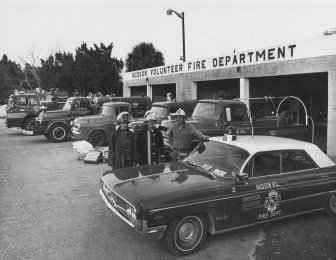 See pictures contributed by Steve Mattix here. In his 2010 history of the HVFD by Stephen C. Mattix, Retired Captain, writes:
The first fire truck was purchased for $1,000 after an area-wide subscription program. On July 28, 1964, the Hudson Volunteer Fire Department answered its first call. A building was completed in early 1965. The Hudson Marina gave a station wagon that was to be equipped for a stretcher, oxygen, and first aid supplies. According to the history, this became the first rescue unit in western Pasco County. Within a few months, two Brush trucks were added. In 1966 a new truck, to replace the first truck, was purchased in Erie, Pennsylvania, and driven to Hudson. By 1967 a Fire-Police car was in operation and a chief’s car was received by donation. All firemen were trained and received a Red Cross First Aid certificate. Around 1973 a new John Beam Pumper was purchased to replace the older one, and a second ambulance was placed into service. In 1974 the Hudson VFD opened a sub-station at Embassy Hills. This facility was built by the volunteers. The first president of the Hudson Volunteer Fire Department was I. L. “Bob” Mawby. On August 1, 1977, Pasco County absorbed the Hudson Volunteer Fire Department. MAGNOLIA VALLEY VOLUNTEER FIRE DEPARTMENTIn 1971, Jim Helm obtained a fire truck and parked it in his front yard in Magnolia Valley. The family ran the Magnolia Valley VFD from their home for about a year until the developer of Magnolia Valley donated the land on Massachusetts Avenue where the station was built. In December 1973 the new firehouse of the Magnolia Valley Volunteer Fire Department was under construction on Moon Lake Road, near the Magnolia Valley and Lakewood Villas subdivisions. Officers were elected as follows: Fire Chief, Ray Lord; Assistant Chief, Jim Helm; President, Rupert Bethel; Vice President, Ted Bass; Secretary, Robert Killion; Assistant Secretary, Ray Lord; First Lieutenant, Floyd Baith. Chester Hill and Ted Bass were elected to two year terms as Board of Director members, and Ray Lord and Robert Russ to one year terms. In July 1987 four fighters with the Magnolia Valley Volunteer Fire Department were arrested and charged with setting fires in the areas where they worked. At the time of the arrest, a Pasco County Sheriff’s Detective said the firefighters could be responsible for setting 50 fires during the past two years. In 1988 a newspaper article reported that the Magnolia Valley Volunteer Fire Department had four fire trucks and three rescue wagons. In the previous year it answered 849 emergency calls. In May 2002 the Magnolia Valley Volunteer Fire Department building became Pasco County Station 29, under a merger of the two departments. Magnolia Valley became the last large volunteer department to join the countywide firefighting effort. Under the new partnership, volunteers and paid firefighters provided the service together. At this time, Anthony Lopinto was the Pasco County Emergency Services Director and Scott Burford was the operations chief for the Magnolia Valley VFD. MOON LAKE VOLUNTEER FIRE DEPARTMENTIn February 1989, John T. Hildebrandt was appointed the new fire chief for the Moon Lake Volunteer Fire Department. He had been with the department for two years as a firefighter and lieutenant. NEW PORT RICHEYThe first fire insurance policy written in New Port Richey was for W. E. and Ralph Gillett for $600 on Feb. 28, 1916, for their house on Central Boulevard, according to the recollection of Gerben DeVries. The next policy was written on March 6, 1916, for $1,500, on the Methodist Church. [Earlier insurance policies were probably sold by companies in Dade City or elsewhere.] In 1917 the business people of New Port Richey purchased a Model T Ford heavy duty fire truck, according to a history of the department read in a 1965 speech dedicating the new fire station. However, a 1917 purchase is not mentioned in other accounts and perhaps the speech is misdating the 1922 purchase described below. According to the 1965 history, this truck did not have a pumper; instead, it had a tank in which the water was carried. Water was obtained from Emil Nyman, who had a large water storage tank. On March 23, 1922, the New Port Richey Press carried the following notice:
On April 13, 1922, the New Port Richey Press reported that two meetings of the New Port Richey Fire Company have been held recently, chaired by President J. W. Clark. It was resolved to eliminate incorporation proceedings as costly and unnecessary. It was decided not to deposit the checks from subscriptions until the entire amount of $1,500 was raised in cash. It was resolved to erect the fire hall of corrugated iron. In 1922, New Port Richey purchased a truck which was apparently an Ajax Chemical Engine mounted on a Ford chassis at a cost of $2000. On Sept. 21, 1922, the New Port Richey Press reported, “The new fire engine was housed in its new home the other day, and it certainly looks a useful instrument. It is fully equipped with chemical extinguishers, fire ladders, axes, spades and other paraphernalia generally found useful at a conflagration.” On Sept. 28, 1922, the New Port Richey Press reported, “A meeting of townspeople interested in the new fire department was held in the Palms Theatre on Tuesday night, when a brigade was formed, with J. W. Clark, Jr., as chief and L. R. Colby as assistant chief. The other members were T. Payson, J. S. Jackson, W. C. Preetorius, F. I. Grey, W. A. Casey, C. Lockard, R. Meyers, Sims, Meeth, G. Warner, E. Carlton, J. Johnson, J. Lindsay, A. J. Fisher, B. Davis, L. C. Poole, F. Luikart, A. Copeland, W. Shendle. The members are resident in the centre of town, and consequently will be within easy call if their services are required. The fire engine and appliances are suitably housed in Main street, and the night marshal Meeth will be in charge of the alarm during the hours of his watch.” On Oct. 5, 1922, the New Port Richey Press carried this notice:
In a 1976 newspaper interview, John W. Beijar recalled, “The first truck was an old ton and a half Model T. Old Jim Clark had that before we started the fire department and kept it in a little tin building on Main Street across from Potter’s parking lot. Then when we got the American LaFrance we was in another tin building on Missouri Ave.” Philip Weachter recalled in the same interview that homes often burned down because of a lack of water. “With the heavy load of water, you just couldn’t get down those sandy roads. And when you were out of water that was it. We didn’t have any fire hydrants.” In July 1925 the American LaFrance fire truck arrived, having been shipped by rail to Tampa and driven to New Port Richey. The truck was tested by pumping water from the river, and a second test was conducted for the benefit of city council by pumping water from Orange Lake. The truck cost about $7,000, according the recollection of George Sims. J. W. Clark was fire chief at this time and Earl Krim was the assistant chief. Krim was put in charge of the care of the two trucks and was given a salary of $20 per month. Next in command were Floyd Sampson and Johnnie Johnson. City council decided to keep the old Ford fire truck at the request of Fire Chief J. W. Clark, who said that the smaller truck, which carried chemical equipment, could be used for many calls. The new water works system had not yet been completed, so at this time Orange Lake and the Pithlachascotee River were used as natural reservoirs to which the pump was attached. In January 1926, James W. Clark Jr. resigned as fire chief. He had held that position since the city was incorporated and was one of the chief organizers of the fire department. He was succeeded by Harold Sheets. A 1926 report on the fire department indicated the city had one American LaFrance type 10 triple combination 600 gallon-per-minute pumper carrying one 40-gallon chemical tank, two five-gallon chemical extinguishers, 200 ft of 3/4-in chemical hose, and 1000 feet of 2 1/2 inch hose. The report said that a volunteer fire department was being organized at that time and that the fire truck was kept temporarily at Gulf Utilities Co. Ice Plant until erection of a fire station.  According to 1930 newspaper article, on November 16, 1926, a meeting was held in the Maxwell Building to discuss the requirements of the city, and on November 22, a permanent organization was formed. At this time the personnel consisted of George Holbrook, chief; H. S. Rothera, president; F. O. Bechtol, vice president; Robert Sims, secretary; Frank Steele, treasurer; Fred H. Swafford, captain; and Mike Olson, Walter Beijar, Keith Sims, P. B. Holmes, Ed Laughtenslager Jr., and Charlie Sims. Larry Fenton was assistant chief. From time to time new members joined until the full quota of 24 men was reached. Under Chief Holbrook’s orders frequent drills were held, the fire truck was put into good shape, and the fire house was rebuilt. In 1928 a small truck was purchased for about $3,000, according to the recollection of George Sims. The New Port Richey Press of July 20, 1928, carried an appeal for contributions to purchase smoke masks for the New Port Richey Volunteer Fire Department. According to the article, the cost of each mask, with goggles and respirator, was $6.00. The department had 24 volunteer men, but only 12 were on duty at one time, so 12 masks were needed. The article identified the fire chief as George Holbrook. Between 1926 and 1932 the fire department was located near the Hacienda Hotel. A July 1929 newspaper account of a fire reported that the fire department had used both the big LaFrance and the new Pirsch fire engines. In 1930 the fire department was incorporated as New Port Richey Volunteer Firemen, Incorporated. The subscribers to the charter as incorporators were: Clifford C. Arnett, Walter Beijar, R. W. Fralick, George S. Holbrook, Gale Lapham, Walter Little, John de Mello, Robert E. de Mello, M. N. Olson, H. S. Rothera, J. Sarment, J. L. Shelton, Robert W. Sims, Keith A. Sims, and Robert E. Tibbits. A 1933 report on the New Port Richey fire department indicated that it was a volunteer department with one chief and 15 men. There was one station of iron-clad construction on the north side of Missouri Avenue. The department had one American-LaFrance type 10 triple combination pumper, chemical and hose truck, capacity 500 gallons per minute, carrying 650 feet of 2 1/2 inch hose, one 40-gallon chemical tank, 200 ft. chemical hose, 2 hand chemical extinguishers, one 12-ft. roof ladder and one 20-ft. extension ladder. The department also had one Model A Ford ladder and hose truck, equipped with booster pump and two 70-gallon booster tanks and 500 ft of 2 1/2l inch hose. A 1000-ft. 2 1/2 inch hose was in reserve. In September 1935, the New Port Richey fire department patrolled the town all night during the Labor Day hurricane. A 1938 newspaper article listed active members as Spencer A. Bentley, Chief; Joseph Fraddosio, Assistant Chief; James E. Grey, Lieutenant; Wilson Fowler, Lieutenant; Theodore Arnett, Mitchell Caraway, Albert Melville, William Bristol, Johnny O’Hara, William Boyd, Fred DeCubellis, Gardner Foskett, James Vickers, Richard Marrs, Robert Sims, E. P. Scofield, Forrest Skeen, Roland Fraddosio, Jack Lewis, Lester Hill, George Whisenant, Raymond Arnett, Henry Falaney, Pete Frierson, Curtis Falany. The article said that, of the group, Mitchell Caraway, Albert Melville, William Bristol, Richard Marrs, and Forrest Skeen were trained first aid men.  In a letter to the editor of the local newspaper in 1938, George Sims wrote, “New Port Richey has had two fire trucks for the past ten years. The big one was bought in 1925 at a cost of about $7,000 and we have only recently finished paying for it. It was a second hand truck when we bought it but we have had 13 years of good use out of it. We also have a small truck which was bought in 1928 at a cost of about $3,000 and we have only just finished paying for that.” In November 1938 the New Port Richey City Council declined to approve the request of Fire Commissioner Tom Staley to purchase a new fire truck at a cost of $3,600 or $3,100, depending on which manufacturer was selected. It decided instead to put the decision on a ballot. During the meeting Fire Chief Spencer A. Bentley, in response to a question from the Mayor, said that the present large truck was not safe to operate. The Mayor ordered him not to move the truck on the streets as a measure of public safety. The city residents voted in favor of the purchase. On Feb. 10, 1939, the New Port Richey Press reported that New Port Richey city council approved the purchase of a new truck from Peter-Pirsch & Sons Co. for $3,750, with an allowance of $200 for the old LaFrance truck “which has been in use since 1914.” The article quoted Fire Chief Bentley as saying the equipment was expected in 45 days. In April 1939 the new fire truck, which cost about $3,600, was delivered. It was temporarily housed in the Ravenhall storage garage with the other fire equipment until the new fire hall on Main Street was completed the following year. The building, at 109 East Main Street, was built with WPA labor and federal aid. It housed City Hall, the fire department, and the library. On June 9, 1939, the New Port Richey Press reported that the two city fire trucks were placed in the new fire hall last weekend. The new fire station, city clerk’s office, and public library were located in the same new building. 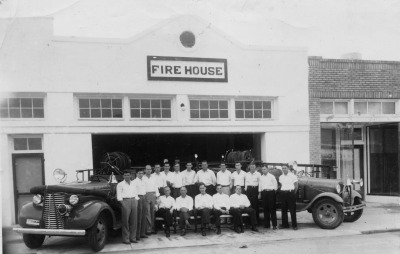 A photograph of the men of the New Port Richey Volunteer Fire Department with the new truck parked in front of the new City Hall-Library-Fire Hall on Main Street appeared in the New Port Richey Press on Feb. 9, 1940. In the photo are Wilson Fowler, 1st Lieut.; Spencer A. Bentley, Chief; R. W. Sims, President; Joe Fraddosio, assistant Chief; James Grey, 2nd Lieut. Standing (left to right): Henry Falany; Joe D’Accardi; Dick Marrs, First Aid; Mitchell Caraway, First Aid; B. H. Gaines; Lester Hill; John O’Hara; James Vickers; James Weiskopf; Bob Foskett; Curtis Falany; Bill Fraddosio; Ted Arnett, Electrician. Not pictured was Clyde (Micky) Poole. In January 1945, the New Port Richey Volunteer Fire Department named Henry Potter to serve as Fire Chief again and Joseph Fraddosio was named assistant chief. Officers elected were Robert Sims, president; J. H. Isaac, vice-president; Russell Thomas, first lieutenant; Yancey Gamble, second lieutenant; H. J. McIntyre, secretary and treasurer. On Mar. 3, 1950, the New Port Richey Press reported: “New Port Richey’s brand new fire truck pulled into the city yesterday morning and the imposing piece of fire fighting equipment drew admiration of onlookers while the firemen took it on practice runs supervised by factory representatives. The machine, designed in its equipment by local fire chief Spencer A. Bentley, cost upwards of $10,000 and is calculated to aid greatly the efficiency of the local fire department. Last night, the Mack Co., makers of the truck, tendered the firemen a banquet at Alexander’s Restaurant, included in the guest list being members of the city council, W. L. Cobb, fire chief and police head of Brooksville, and others.” 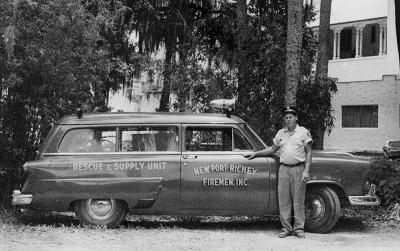 A photograph in the New Port Richey Press of Oct. 11, 1956, shows New Port Richey Fire Chief Ray Ernest and volunteer firemen Rupert Bethel, Robert Sample, Bob Russ, Fred Koning, and Thomas Weiskopf. They are standing next to a four-wheel drive truck recently purchased by the department, especially adapted for fighting brush fires in remote areas. 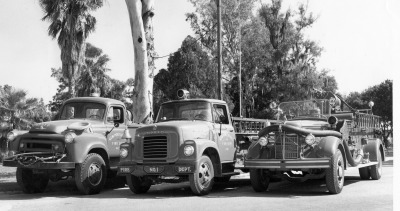 A 1963 brochure published by the New Port Richey Volunteer Fire Department is here. In May 1965, speaking at the dedication of the new New Port Richey fire station, attorney Richard J. Milbauer recalled:
The new New Port Richey fire department building was dedicated on May 14, 1965. The principal speaker was Richard J. Milbauer, who listed some of the past fire chiefs: H. R. Rothera, Henry Potter, Spencer A. Bentley, Robert Sample, Joe Fraddosio, Ray Ernst, and Charles Trufant, who was the current chief. Milbauer said that there were currently 21 members in the department and that they met on Thursday evening at 7:30. In 1970 Dave Melden, a former New Port Richey policeman, was named the fire chief of New Port Richey. According to a 1974 newspaper article, at that time several of the then predominantly volunteer firemen walked out and formed the Magnolia Valley Volunteer Fire Department. Melden converted the department to one staffed by only paid firefighters. In a 1974 newspaper interview, Melden said, “I admire volunteers, and I think they serve a need, but I felt that paid men would serve the city better. Paid men are more dedicated and they are easier to train.” In 1973 Capt. Roy R. Miller reported that the New Port Richey Fire Department had twelve active, salaried firefighters. The department had three pumpers (a 1950 Mack, a 1971 Ward LaFrance, and a 1973 Ward LaFrance), a 1971 rescue van, two cars, and a 1964 Jeep Rescuba Squad, which was added in July 1973. In September 1974 the New Port Richey Fire Department opened its second station, on High Street. The station, built for about $65,000 by John Earl Larson, consists of a two-story central section flanked on either side by truck bays. According to a newspaper article in 1974, one of the bays housed a 1,000 gallon-per-minute Class A pumper that was purchased for $40,000, and the other bay would contain an $18,000 mini-attack pumper which was then on order. An article in West Pasco’s Heritage (1974) reported that “Under the leadership of fire chief Dave Melden, the department has increased its efficiency through intensive periodic training classes for the department personnel as well as hospitals, schools, nursing homes, etc., in proper evacuation procedures, use of fire extinguishers and updated fire fighting techniques. Inspection of buildings and businesses are made at regular intervals with continued vigilance maintained for the safety of all citizens.” In 1977-78, Melden, then in Tampa, served as President of the Florida Fire Chiefs Association. In 1984 Roy R. Miller became the New Port Richey Fire Chief. Miller had become a volunteer firefighter in July 1971, and when a firefighter position opened in June 1972, he applied for it. The pay was $1.88 per hour. In December 1991 the New Port Richey City Council voted 4-0 to discontinue negotiations with Pasco County about consolidating fire services. County Emergency Services Director Amador Gonzalo had estimated the city could have saved as much as $700,000 if the county had taken over. On October 4, 1993, the expansion of the main New Port Richey fire station at 6333 Madison Street was dedicated. On June 1, 1994, Roy R. Miller retired as the New Port Richey fire chief. In November 1994 Harold W. Burns was hired as the New Port Richey Fire Chief. At this time the department had 25 employees. Earlier that year the city obtained a new fire truck with a 75-ft. ladder. In December 1995, Daniel Azzariti, 39, an 18-year-veteran of the New Port Richey fire department, was named its new chief. He succeeded Harold Burns, who had resigned in September. 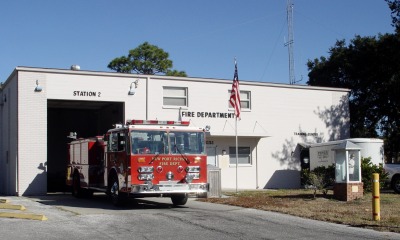 In 2003 the New Port Richey Fire Department had its main station at 6333 Madison Street and a second station at 6121 High Street. The department consisted of 26 career personnel along with 20 part-time firefighters under the direction of Chief Dan Azzariti. 
Scene from a Prom Promise presentation at Gulf High School, May 7, 2004 In September 2008 Dan Azzariti retired as New Port Richey fire chief after 31 years with the department. He had held the top position since 1995. He was succeeded by Alex Onishenko. In 2015, fire chief Chris Fitch was named. 
The New Port Richey main fire station in 2009 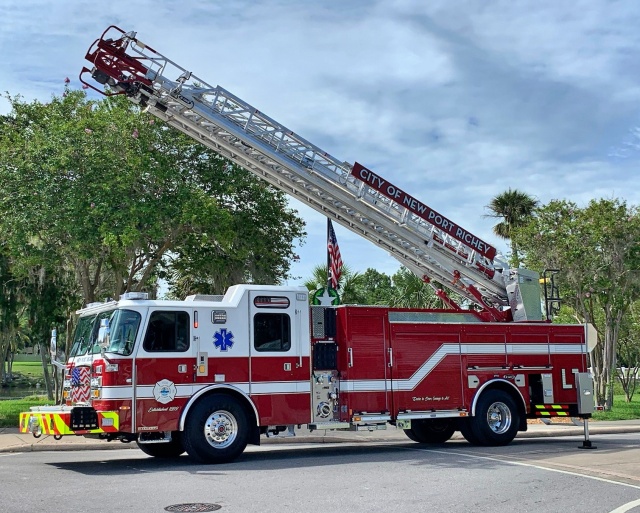 In 2022, Chief Adam Darling is the current Deputy Fire Chief/Fire Marshal. PASCO COUNTY EMERGENCY SERVICESIn 1982 Amador Gonzalo was hired as the emergency services director of Pasco County. He held the position for 13 years. The fire department training center is named after Mr. Gonzalo, who is credited with integrating the county’s fire and ambulance services, as well as upgrading equipment across the fire district. In April 1988, county emergency workers took over the Highway 52 Volunteer Fire Department building at 10417 Frierson Lake Drive in Hudson after the County Commission voted to provide emergency protection to the area. Under the terms of its charter, the Highway 52 Volunteer Fire Department gave all of its assets to the county. The VFD had disbanded a few days earlier following an internal dispute over disciplinary procedures planned against the group’s assistant fire chief. In June 2000 Matthew Ballaban, director for Pasco County’s Emergency Services, ended his five-year tenure with the county. In December 2003, the Pasco County Fire Rescue website indicated the department had a total of 18 stations, fourteen of which were combined fire and rescue stations, one of which was rescue only, and three were combat only. There are also three all-volunteer stations. The organization had approximately 290 paid professionals and over 100 volunteers, along with a support staff of approximately 50 people. It is a cross-trained department in which all of the paid fire fighters are required to be trained as EMT’s and emergency medical personnel are required to be trained as firefighters. Pasco County Fire Rescue began as a career fire department in 1974. The website listed these personnel: Director of Emergency Services, Anthony Lopinto; Administrative Services Chief, Allan McCray; Assistant Chief, Christopher Alland; and Fire Marshal, Larry Whitten. On May 20, 2005, Pasco County Fire Rescue workers voted 159-136 to unionize. A Tampa Tribune article at that time reported that the department was unionized by the Teamsters for about 15 years until that local union dissolved in 1998. In June 2006 a new county firehouse in Embassy Hills began operation. It was located at 6700 Rielly Court, and replaced an older facility at 9506 Crabtree Lane. On Oct. 21, 2008, a ribbon-cutting ceremony was held for the new Heritage Pines Station No. 39 at 11630 County Line Road, just south of the Hernando County line. An advanced life support firetruck with a paramedic on board, a brush truck, and a 1,500-gallon tanker are based at the station that has two drive-through bays. The living quarters sleeps seven employees. PORT RICHEY VOLUNTEER FIRE DEPARTMENT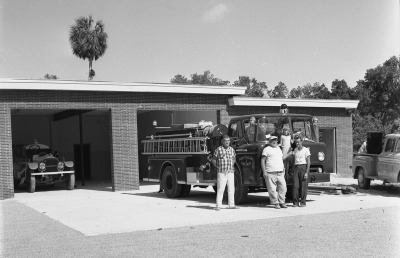 A 1964 booklet gives the following history of the Port Richey VFD:
When the Port Richey VFD was organized, Basil Gaines was Fire Chief and Francis Fisher was Assistant Chief. Members were Russell Locastro, Harry Clark, James Cardnell, Edwin Speller, William Sakelson, and Harold Lorenzen. On Nov. 3, 1960, the New Port Richey Press printed a photo with the caption, “Port Richey Fire chief Basil Gaines, left, and Assistant Chief Harry Clark, prepare to take a spin in ‘Honey Girl,’ 40-year-old American-LaFrance fire truck purchased for $300 recently from the St. Petersburg Beach fire department for training purposes. Chief Gaines and other members of the newly organized Port Richey fire department figure that the expenditure for the ancient fire wagon was a wise investment, since the oldtimer is performing admirably.” Another source identifies the truck as a 1921 Ward LaFrance fire truck. Later in 1960 the Port Richey city council voted to purchase a new LaFrance fire engine at a cost of $17,296. A used Army Dodge was purchased by Port Richey in 1965 and entirely rebuilt by the volunteers to be used as a brush fire truck. With the aid of the ladies auxiliary, the Port Richey firemen were able to purchase a 1966, four-wheel drive, three-quarter ton truck to be used as an off-the-road fire control unit. In 1974 the Port Richey Volunteer Fire Department had 19 active members, all volunteers. Chief Wilbert Wellman had two assistant chiefs, Joseph Donahue and Vic Miller. In 1987 the Port Richey Fire Department, which had been strictly volunteer, hired its first paid employee, according to a 1988 newspaper article. In 1993, Port Richey fired and then rehired its fire chief Dennis Smith. He was succeeded later in 1993 by Tim Fussell, who was hired as part-time fire chief. Fussell had been a Pasco County fire-rescue chief for 22 years. In May 1993 Port Richey City Council voted to buy two used fire trucks for $95,000 to replace the city’s current pair, one of which did not run. They were a 1980 Mack fire truck with a stainless-steel water tank and 22,000 miles on it and a 1982 “E-1” truck with 19,000 miles and an all-aluminum body. 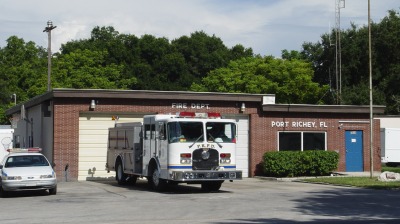 SAN ANTONIO VOLUTEER FIRE DEPARTMENT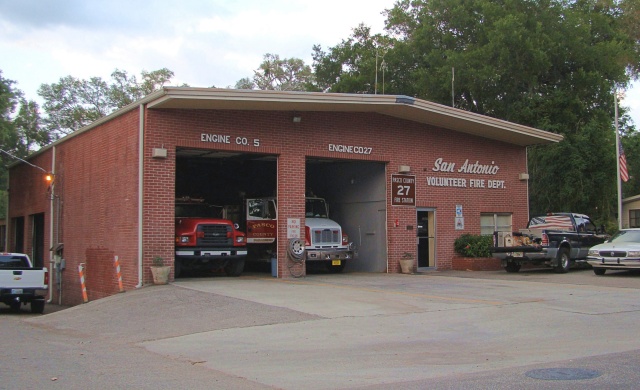 This article is taken from a 1964 booklet. The San Antonio Volunteer Fire Department was organized in 1947, at which time Al Vogel was elected our first president; Eddie Flicker, vice president; Bert Atwater, Fire Chief; and Walter Barnes, Engineer. Prior to 1947 the community’s only fire protection was a two-wheeled hose cart that had to be connected direct to the fire hydrant. Our first fire truck was a 1914 American LaFrance purchased from the Lake City Fire Department in 1947. In 1949 new officers were elected and consisted of Frank Hill as Chief, Ralph Jones as Assistant Chief, with Henry Pike and Wallace Dawson as Engineers. A 1946 Ford with a Howi 500 G. P. M. midship pump was purchased in 1953 from U. S. Navy surplus. New officers were elected in 1956 and consisted of Ed Storch as president, Eddie Herrmann as vice president, Frank Hill as Chief, Donald Storch as Assistant Chief, Mrs. Betty Korchak as secretary, Oscar Nelson as treasurer, and Hugh Dunne as Engineer. During 1956 the need for a tank truck was becoming apparent, so a 1550-gallon fuel truck was located in Jacksonville. It was purchased and converted to a very efficient tanker fire truck so as to handle fire calls when a source of water is not available. In 1961 two way radios were installed in the two fire trucks and four of the firemen’s cars. In 1962 we purchased a brand new Chevrolet two-ton truck chassis and transferred the equipment from the 46 Ford so that it now carries a 400-gallon booster tank, 1700 feet of hose, a 500 G. P. M. midship pump, and a 300 G. P. M. front-mount pump. The present officers are Ed Storch, president; Hugh Dunne, vice president; Donald Storch, Chief; and Fred Steiert, Assistant Chief and treasurer. A picture from the article is here. SOUTHWEST PASCO VOLUNTEER FIRE DEPARTMENTThe Southwest Pasco VFD incorporated in October 1965 according to a June 1966 article in the Tampa Tribune. The 1966 newspaper article reported that the group consisted of 22 volunteers and has acquired three fire trucks, a garage, and a meeting place. It reported the fee to obtain fire protection was $4 per year and that at present there were over 1,800 paid up memberships with a potential of 4,500. The article reported that the volunteers are supervised by H. E. Strauber, who had 20 years experience as fire commissioner in New York State, and R. C. Auld, a retired fire chief with over 30 years experience. The President was Jerry Austin. On April 28, 1973, the Southwest Pasco Volunteer Fire Department dedicated its second station at 260 Dove Drive in Colonial Hills in Holiday. TRI-COMMUNITY FIRE ASSOCIATIONThis article was taken from a 1964 booklet. The Tri-Community Fire Association was formed by a few residents of Lacoochee, Trilacoochee, and Trilby for the purpose of obtaining some fire equipment with which to train and maintain a volunteer fire department to serve the surrounding area. Anyone can be either an active or honorary member of the association. We meet the second and fourth Tuesday of each month at Lacoochee at 7:30 P.M. The association is also a member of the Pasco County Fire Association. The first meeting was held at the Lacoochee school on September 29, 1961, and with the help of Mr. Wm. Brewton was chrartered by the state of Florida on November 28, 1961. The officers for the first few months prior to a regular election were: Mr. Ben Leasure, president,and Mrs. Owen L. Powell, secretary and treasurer. The elected officers were: Mr. Danny Roberts, president; Mr. Joe Hillman, vice president; Mrs. Mildred Leasure, recording secretary; Mrs. Owen L. Powell, treasurer and corresponding secretary. We have raised money with turkey shoots, auction sales, talent shows, horse shows, and rodeos, and donations. Our rodeo arena is located on highway 301 just north of Trilacoochee on the property of Mr. M V. (Shorty) Daley. We have held our annual Fourth of July rodeo and many horse shows at this arena. After much time and effort, on June 25, 1963, we had the opportunity to purchase a truck through Civil Defense. It is a 750 gallon 1946 model Chevrolet ex-Navy tank truck and of this date is equipped and ready to fight fire in our area which has been extended to include the Ridge Manor area. We are now trying to prepare an extra tanker to use to haul water to the fire truck. We are also working toward getting property and building a fire station. Chief Danny Roberts holds training sessions every Monday night at 7:30 and invites everyone to come for training. We would like to thank all the people who have helped in getting us as far as we have, but we need a lot more help so we can go a lot further. We will be running a membership drive soon so watch for our members. U. S. 19 VOLUNTEER FIRE DEPARTMENTThe U. S. 19 Volunteer Fire Department, Inc., held its organizational meeting on Dec. 7, 1959. It received its Florida charter eight days later. Forty members attended the organizational meeting at the old fire hall at Hudson. The first elected officers were James Englhert, Richard Olson, Ed Rumminger, W. Jackson, and H. Fredfield. A truck was purchased for $900. It was nicknamed “Big Kate.” This organization apparently failed to develop into a significant firefighting organization. He Recalls the Days of Area’s First Fire DepartmentThis article appeared in the West Pasco Chronicle on July 3, 1968. By BOB I first came here to visit my brother, who like myself had been released from serving Uncle Sam during that long distant First World War. My brother came here in the early spring of 1922 and opened up a garage. I came down in the fall of the same year, October 15 to be exact. After the first week of fishing (and it was good in those days) I tired of fishing. Being accustomed to chasing rainbows and due to the fact there were very few people of my own age group, or I might add any other age group, I got to the point where I would say to myself: “If the Good Lord lets me live until tomorrow, I will leave this village.” However, as time passed the few families living here saw the need for fire protection, as this area consisted mainly of underbrush, palmetto scrub, rattlesnakes, wildcats, and wild pigs. So through donations and various methods a Model T chassis was purchased. A builder volunteered to build a body on this chassis. The next step was to equip the truck with fire fighting tools, again it was donations, and auctions. Finally we had our fire truck with chemicals, ladders, plus a few five gallon water tanks, that you strapped on your back and worked with a little hand pump. A couple of rakes, four shovels, axes, eight water pails and a 14 foot ladder was also included in our equipment. Now we were ready to do battle with come what may, be it fire, rattlesnakes, wildcats, hurricanes, etc. Those fellows volunteered for any and every hazard that might come up to help others keep out of danger. Our first fire station consisted of a 12 by 14 frame, floorless building covered by sheet metal, sides and roof. It was on the lot east of the Chasco Inn. On the Boulevard side it was low and every time it rained we would have a good mud hole for the pigs and a swimming hole for the ducks! If we had to go west to the boulevard to answer a call it would be necessary for someone to chase ducks and pigs out of the street so the truck could get through without scattering animals in every direction. After the town was incorporated the fire station was moved to the corner of Bank St. and Missouri Ave. It remained there for several years. Many streets were paved and the pigs and ducks lost their playgrounds to progress. It was while the truck was at this second location that one day when answering a grass fire in the north east part of town, we passed the school house (now city hall) I noticed a beautiful blonde school marm, herding her charges back from the street (we were speeding along at a fantastic 25 M.P.H.). I couldn’t get this beautiful teacher from my mind, consequently I stepped into a hole of hot ashes and severely burned my foot. While my foot was healing I berated myself for nearly losing a foot over a pretty blonde; but soon I lost more, my head and my heart. She became my wife! Our much loved, but rather odd looking fire truck had to be retired. It was put to pasture on Missouri Ave. As more streets were being paved, and New Port Richey was continuing to grow. The city fathers bought a second hand La-France fire truck solid rubber tired five hundred fifty gallon pumper to be used with our brand-new red fire hydrants. This pumper was our pride and joy: as long as we could keep it on the pavement. On the pavement we went forward, in the sand we went down! Our next piece of equipment was also a pumper. This was a then modern truck with air filled tires also smaller and lighter than the LaFrance. It served well in sand. Both of these trucks had 100 gallon tanks on them. Attached was about 300 feet of 1 1/2 hose, on a small reel. A big day came when we were called to an out of town fire, which gave us valuable experience. We had to pump water from a lake. The buildings burned, but we saved the lake! (You can’t win them all!) However, most of our fires were woods fires. Most of this area consisted of heavy brush and palmetto, grape vines, oaks and pines. With few roads to act as fire breaks, we had some fires that were very severe. I remember many fires that were higher than our tallest buildings. Many were the times we had to turn tail and run. However, as we grew and with more experience, more and newer equipment, we learned to control these wild fires and they’ll never be as wild again. Then we had pretty much the same fire alarm signals as now, except we did not have many telephones. Also, our electricity was turned off at midnight. The town was divided into four zones and after midnight the alarm was two quick blasts from a revolver or shotgun. One night, our night policemen came into contact with a twelve foot alligator. He emptied his revolver into the gator so fast the town was soon filled with firemen in old-fashioned long underwear, and nightshirts flapping in the breeze. Another time a man heard a commotion in his hen house and thought that a wild animal was running among his hens. Grabbing his double barrel shotgun he dashed to the hen house and was leaning over the fence peering into the hen house when just at that moment his old hound dog ran up behind him and stuck his cold nose up under his night shirt, causing him to fire both barrels killing six hen! Naturally, the fire department was swiftly on the scene. We could only comfort the man. While fighting a fire down around Miller’s Bar, I noticed a crate of bottles in the saw grass. Upon investigation I could see it was a case of whiskey which someone had lost from bygone days. Next day half the male population had “Hangover” and had some very perturbed females to deal with. This was just one of the hazards that the fire department dealt with back then. Another very real hazard was the many rattlesnakes, which were always in the brush, and a very real and constant danger. In conclusion I wish to mention some facts that all of us should be very proud of. Our department actually began in November 1922, that was before incorporation and this is 1968, the 46th year. During this whole time we have never lost a life due to a fire. Not even a person injured, nor a wrecked truck. Only some minor cuts and bruises and smoke inhalation. The only fair maiden rescued by ladder was made by a policeman! That was the night we buried our LaFrance truck so deep in the sand it took three days to dig it out. At first we held a “Firemen’s Ball” usually in the Hacienda Hotel. This was the social event of the year. Now for the past few years the firemen give the townspeople and visitors a free fish-fry on the fourth of July. These men work most of the night before preparing hundreds of fish then cooking and serving them the next day. They also make several hundreds pounds of cole stow, baked beans, coffee, etc. They put in about 20 hours of hard work, for our pleasure and also to encourage us to keep off the busy holiday highways, that we may have a better chance of survival. |
Some Notable Fires in Western Pasco County
| 1880s | The Hudson School is said to have been destroyed by a fire. |
| 1888 | A church in Elfers, destroyed. |
| 1889 | The Vereen School. Damage unknown. (Mentioned in Sept. 1889 school board minutes.) |
| April 1889 | Store and post office in Hudson. Destroyed. |
| Apr. 1907 | The Fivay sawmill, destroyed. |
| Nov. 1916 | Barn and outbuildings belonging to Severi Neimi, three miles north of New Port Richey, destroyed. The early morning fire was apparently the work of an arsonist. |
| 1920 | The Vereen School, destroyed. |
| June 1921 | Residence of A. C. Casson, known as the old Hill place, one of the oldest homes in the area, destroyed Neighbors arrived but the explosion of cartridges inside the building deterred them from entering. |
| Feb. 1922 | Residence of W. K. Jahn, know as Nicco Nook, destroyed. Apparently caused by the explosion of a gasoline stove in the kitchen. |
| May 10, 1922 | The Hudson Pentecostal (or Church of God) building, destroyed. |
| Apr. 2, 1923 | The boat house belonging to Warren E. Burns, which had been used as an apartment and boat house, destroyed. The smoke first appeared where the electric wires entered the building. A newspaper reported, “The fire department made a good run to the scene, but the alarm was not turned in in time for them to save the house. However, by their good work they undoubtedly saved Dr. Avery’s bungalow….” |
| May 25-26, 1926 | The Enchantment Inn adjacent to Orange Lake, destroyed. About 500 residents had arrived to view the fire by the time it ended. Sixty men, grappling with fire hose and buckets, attempted to put out the flames. Michael N. Olson later recalled, “We had to protect the Maxwell Building next to the hotel. There was no hope for the Sass Hotel with its tar roof and wood frame.” |
| January 1927 | The lumber mills in Odessa. The New Port Richey fire department assisted. |
| March 4, 1927 | The Tarpon Inn in Tarpon Springs, destroyed. The New Port Richey fire department assisted, arriving on the scene 16 minutes after receiving the call, and was pumping water three minutes later. |
| July 1929 | The Bay Lea Inn, saved. A bath house at the rear of the hotel was destroyed, but the main building was saved. The big LaFrance and the new Pirsch fire engines were sent. |
| Jan. 30, 1938 | The Palms Theatre on Main Street, destroyed. James E. Grey later recalled that he cranked the pumper on the American LaFrance as the firemen battled the intense flames; he was not yet in his teens. The fire was apparently set accidentally by a child. |
| Feb. 18, 1938 | Methodist Church in Hudson, destroyed. |
| May 7, 1940 | Gaston’s Grocery Store, Elfers, destroyed. |
| Dec. 1941 | Laundry building owned by E. Z. Jackson, operated by Mrs. Belle Butler, destroyed. |
| Jan. 23, 1943 | Gulf Springs Lodge in Hudson, destroyed. |
| May 1945 | Hudson School, destroyed. |
| 1953 | Pasco Hardware, “almost destroyed.” |
| Dec. 5, 1961 | Residence of Martha Oelsner in Port Richey, destroyed. Many valuable works of art and other relics were destroyed. |
| March 1966 | The Elfers Citrus Growers Association packing house, destroyed. |
| December 1966 | American Legion Hall on Main Street in New Port Richey, destroyed. |
| 1976 | Standard Gas Station. Gasoline was ignited from a spark from a neon light, the flames lighting up the block. |
| July 17, 1976 | Lumber yard of Pasco Building Supply, U. S. 19, south of State Route 52. Destroyed. $250,000 damage. Three firemen were hospitalized. Fire believed to be arson. |
| Jan. 25, 1977 | New Port Richey Moose Lodge destroyed. |
| Sept. 1980 | Moose Lodge in Holiday, destroyed, $500,000 damage. |
| June 3, 1987 | The Backstreet Pub, Pizza Joe’s, Jimmy’s Restaurant, and McKendree Greens, four businesses in downtown New Port Richey, destroyed. Twelve firefighters were injured. Damage was estimated at $500,000. About 50 to 60 firefighters, from New Port Richey, Port Richey, Pasco County and the Magnolia Valley Volunteer Department, battled the blaze at one time. |
| June 20, 1988 | Two young boys were killed in a mobile home fire at Shady Hills. |
| July 26, 1988 | The Department of Health and Rehabilitative Services (HRS) district office at 7809 Massachusetts Ave., near New Port Richey, destroyed. The fire was set by an arsonist. |
| Jan. 15, 1989 | The Gold N’ Spur, a bar on Little Road, damaged. The fire was set by an arsonist. |
| Nov. 15, 1989 | A vacant two-story apartment building in Elfers, destroyed. The building was also known as the old Edenfield home, built in 1932, located across the street from the old Edenfield store, an unusual stone building. |
| Sept. 22, 1996 | The lodge at the Moon Lake Gardens and Dude Ranch, which had been vacant in recent years, destroyed. Fire was believed to be set by an arsonist. |
| June 25, 1998 | Leisure Beach Restaurant |
| Nov. 30, 1998 | Sam’s Hudson Beach Snack Bar, 6325 Clark Street, Hudson. Heavily damaged. The fire was set by an arsonist. |
| Oct. 30, 2001 | Accurate Auto Parts, 18736 U. S. 19, Hudson, destroyed. |
| March 25, 2002 | Lakeview Rodeo. Damage to the building estimated at $300,000. |
| Aug. 21, 2003 | Leverock’s Waterfront Grill, saved. Damage estimated at over $1,000,000. |
| Oct. 1, 2004 | Kountry Kitchen, U. S. 19, Port Richey. Destroyed. Two neighboring businesses were damaged. The owner believed the fire was started by men repairing roof damage from Hurricane Jeanne; they had been using a propane tank. |
| Dec. 3, 2005 | Douglas M. Rucker Auto Parts, 4707 Voorhees Road, New Port Richey, destroyed. Arson suspected. |
| July 4, 2007 | Galaxy Fireworks stand, destroyed. A man lit a firework and intentionally caused an explosion. Two injuries. |
| Mar. 7, 2009 | Liberty Fireworks in Holiday. Angelo Carbone, 39, the owner of the store, died in the fire. |
| Aug. 3, 2010 | Lakeview Baptist Church in Hudson. Destroyed. |
| Jan. 14, 2018 | A Sun Cruz boat catches fire at Port Richey, forcing about 50 passengers to jump into the Gulf in cold weather. The boat was destroyed. |
